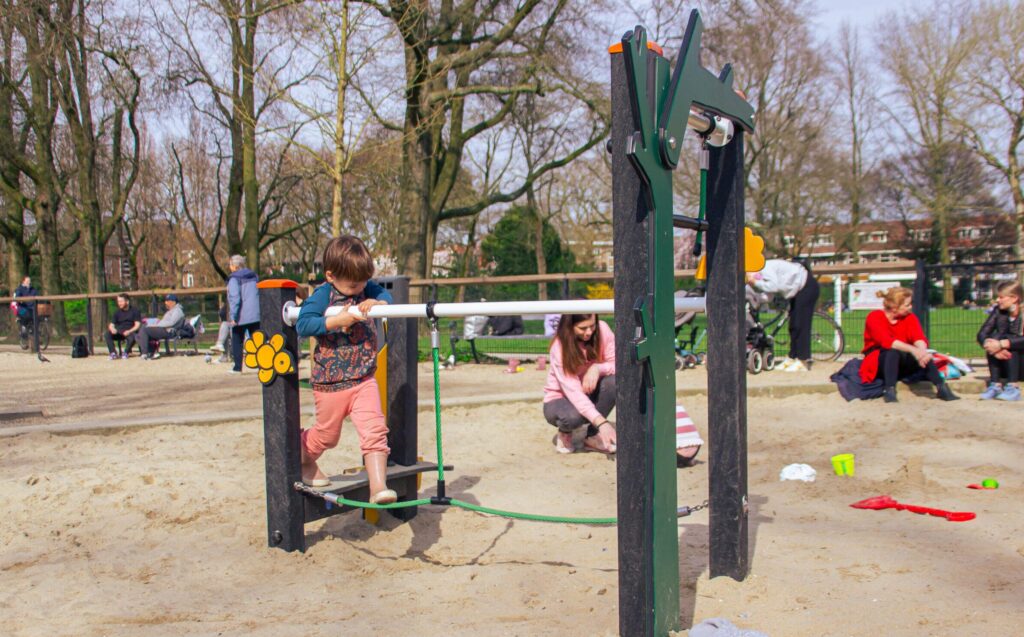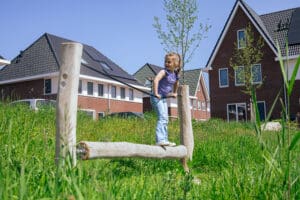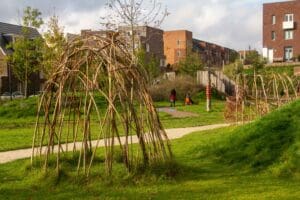Research by Jantje Beton shows that the number of children playing outside has halved across the Netherlands in recent years. A lack of play space plays a major role in this decline. In urban areas, more and more play areas are disappearing due to the increasing pressure on available space in densely built-up neighbourhoods.
In this blog, we explain why play areas are essential.
Current urban development regulations do not include strict guidelines for allocating play space within a neighbourhood. This is partly because the focus is on other urban needs, such as housing and parking spaces. As a result, play areas are often the first to disappear when space is limited. This is a great loss for young children in the neighbourhood and also impacts other residents. Architect and researcher Janna Bystrykh put it well in de Volkskrant: “Playgrounds are democratic spaces where young and older residents of the neighbourhood cross paths.” These meeting places are important for both social cohesion and the overall health of a community. At BOERplay, we design play areas so that children, teenagers, adults, and the elderly all enjoy spending time there. This way, a play area becomes more than just a place to play – it becomes a meeting place for everyone. Play areas are invaluable for children and the wider community. Would you like to know how a well-designed play area can improve the liveability and well-being of your neighbourhood? Our advisors are happy to help you create a play space that meets the needs of children while also enhancing social cohesion, ecological value, and urban health. Together, we can create a play area that suits your neighbourhood and the wishes of its residents. Get in touch with us and discover how we can make a difference together. Beyond their social function and contribution to child development, play areas also offer ecological and urban benefits. They play a key role in climate adaptation and improving the quality of life in densely populated city districts. At BOERplay, we take these aspects into account when designing our play areas: By incorporating natural elements such as trees, grass fields, and shrubs into our designs, we bring more greenery into the city and improve the liveability of urban areas. Many city neighbourhoods are dominated by concrete and asphalt, which not only look monotonous but also negatively impact air quality and biodiversity. By integrating greenery into play areas, children get a pleasant environment to play in, and the neighbourhood becomes more attractive for all residents. Trees and plants also help purify the air by absorbing CO₂ and fine dust particles. Green play areas encourage children to engage in natural play and exploration, fostering their creativity and motor skills. Cities are increasingly struggling with heavy rainfall, leading to flooded streets and squares. This happens because rainwater cannot easily drain through the hardened surfaces of urban areas. A play area with green elements plays a crucial role in capturing and retaining rainwater. By incorporating grass fields, wadi systems, and permeable surfaces into the design, rainwater is naturally absorbed and drained away. This reduces pressure on the sewage system and lowers the risk of flooding. Additionally, this form of water management helps prevent soil dehydration during dry periods, ensuring the neighbourhood remains greener and healthier in summer. Heat stress is becoming an increasing problem in cities, as concrete and stone retain heat and offer little cooling. On hot summer days, this is particularly challenging for children and the elderly. Green play areas provide a solution. Trees and shrubs create natural shade and lower temperatures through evaporation. As a result, green play areas feel significantly cooler than paved squares or asphalt playgrounds. Grass and vegetation help regulate temperatures, creating a more pleasant and healthier living environment for the entire neighbourhood. By consciously choosing natural materials and strategically placing shaded areas, our play areas help combat urban heat issues.Play areas are more than just playground equipment

Increasing nearsightedness in children
 What does the disappearance of play areas mean for children? Outdoor play is essential for children’s development, improving their physical, motor, and cognitive skills. But that’s not all – it also affects their overall health, particularly their eyesight. Research shows that regular outdoor play and exposure to natural light have a significant impact on children’s eye health. Daylight stimulates dopamine production in the eye, which helps slow down the growth of the eyeball and prevents or delays myopia (short-sightedness). When children spend more time playing indoors, the risk of developing myopia increases. Ensuring children get enough time outdoors is therefore crucial for healthy eye development.
What does the disappearance of play areas mean for children? Outdoor play is essential for children’s development, improving their physical, motor, and cognitive skills. But that’s not all – it also affects their overall health, particularly their eyesight. Research shows that regular outdoor play and exposure to natural light have a significant impact on children’s eye health. Daylight stimulates dopamine production in the eye, which helps slow down the growth of the eyeball and prevents or delays myopia (short-sightedness). When children spend more time playing indoors, the risk of developing myopia increases. Ensuring children get enough time outdoors is therefore crucial for healthy eye development.Make your municipality more play-friendly!
Key benefits of play areas in the city
Greening the neighbourhood

Rainwater retention

Play areas combat heat stress


